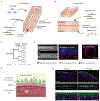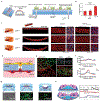Building Blood Vessel Chips with Enhanced Physiological Relevance
- PMID: 37693798
- PMCID: PMC10489284
- DOI: 10.1002/admt.202201778
Building Blood Vessel Chips with Enhanced Physiological Relevance
Abstract
Blood vessel chips are bioengineered microdevices, consisting of biomaterials, human cells, and microstructures, which recapitulate essential vascular structure and physiology and allow a well-controlled microenvironment and spatial-temporal readouts. Blood vessel chips afford promising opportunities to understand molecular and cellular mechanisms underlying a range of vascular diseases. The physiological relevance is key to these blood vessel chips that rely on bioinspired strategies and bioengineering approaches to translate vascular physiology into artificial units. Here, we discuss several critical aspects of vascular physiology, including morphology, material composition, mechanical properties, flow dynamics, and mass transport, which provide essential guidelines and a valuable source of bioinspiration for the rational design of blood vessel chips. We also review state-of-art blood vessel chips that exhibit important physiological features of the vessel and reveal crucial insights into the biological processes and disease pathogenesis, including rare diseases, with notable implications for drug screening and clinical trials. We envision that the advances in biomaterials, biofabrication, and stem cells improve the physiological relevance of blood vessel chips, which, along with the close collaborations between clinicians and bioengineers, enable their widespread utility.
Keywords: COVID-19; angiogenesis; disease modeling; drug screening; hemodynamics; permeability; rare disease.
Conflict of interest statement
Conflicts of Interest YSZ sits on the scientific advisory board of Allevi by 3D Systems and Xellar, which however, did not participate in or bias the work.
Figures










Similar articles
-
The Applications and Challenges of the Development of In Vitro Tumor Microenvironment Chips.Cell Mol Bioeng. 2022 Dec 26;16(1):3-21. doi: 10.1007/s12195-022-00755-7. eCollection 2023 Feb. Cell Mol Bioeng. 2022. PMID: 36660587 Free PMC article. Review.
-
Tunable Microstructured Membranes in Organs-on-Chips to Monitor Transendothelial Hydraulic Resistance.Tissue Eng Part A. 2019 Dec;25(23-24):1635-1645. doi: 10.1089/ten.TEA.2019.0021. Epub 2019 Sep 3. Tissue Eng Part A. 2019. PMID: 30957672
-
Bioinspired Engineering of Organ-on-Chip Devices.Adv Exp Med Biol. 2019;1174:401-440. doi: 10.1007/978-981-13-9791-2_13. Adv Exp Med Biol. 2019. PMID: 31713207 Review.
-
Organ-on-chips made of blood: endothelial progenitor cells from blood reconstitute vascular thromboinflammation in vessel-chips.Lab Chip. 2019 Jul 23;19(15):2500-2511. doi: 10.1039/c9lc00469f. Lab Chip. 2019. PMID: 31246211 Free PMC article.
-
3D Engineering of Ocular Tissues for Disease Modeling and Drug Testing.Adv Exp Med Biol. 2019;1186:171-193. doi: 10.1007/978-3-030-28471-8_7. Adv Exp Med Biol. 2019. PMID: 31654390
Cited by
-
Fabrication of endothelialized capillary-like microchannel networks using sacrificial thermoresponsive microfibers.Biofabrication. 2024 Nov 19;17(1):015023. doi: 10.1088/1758-5090/ad867d. Biofabrication. 2024. PMID: 39401530 Free PMC article.
-
Acoustic Bioprinting: A Glimpse Into an Emerging Field.Small Methods. 2025 Jul 26:e2500733. doi: 10.1002/smtd.202500733. Online ahead of print. Small Methods. 2025. PMID: 40713816 Review.
-
Sustained Delivery of the Antiviral Protein Griffithsin and Its Adhesion to a Biological Surface by a Silk Fibroin Scaffold.Materials (Basel). 2023 Aug 9;16(16):5547. doi: 10.3390/ma16165547. Materials (Basel). 2023. PMID: 37629837 Free PMC article.
-
Engineering Synthetic Erythrocytes as Next-Generation Blood Substitutes.Adv Funct Mater. 2024 Jul 10;34(28):2315879. doi: 10.1002/adfm.202315879. Epub 2024 Feb 8. Adv Funct Mater. 2024. PMID: 39386164 Free PMC article.
-
Leveraging femtosecond laser machining for the fabrication of tubular-based Organ-on-Chip systems: modeling cancer metastasis from invasion to intravasation.Mater Today Bio. 2025 May 29;33:101926. doi: 10.1016/j.mtbio.2025.101926. eCollection 2025 Aug. Mater Today Bio. 2025. PMID: 40585039 Free PMC article.
References
Grants and funding
LinkOut - more resources
Full Text Sources
